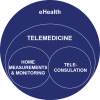Telemedicine for Kidney Transplant Recipients: Current State, Advantages, and Barriers
- PMID: 37264512
- PMCID: PMC10798592
- DOI: 10.1097/TP.0000000000004660
Telemedicine for Kidney Transplant Recipients: Current State, Advantages, and Barriers
Abstract
Telemedicine is defined as the use of electronic information and communication technologies to provide and support healthcare at a distance. In kidney transplantation, telemedicine is limited but is expected to grow markedly in the coming y. Current experience shows that it is possible to provide transplant care at a distance, with benefits for patients like reduced travel time and costs, better adherence to medication and appointment visits, more self-sufficiency, and more reliable blood pressure values. However, multiple barriers in different areas need to be overcome for successful implementation, such as recipients' preferences, willingness, skills, and digital literacy. Moreover, in many countries, limited digital infrastructure, legislation, local policy, costs, and reimbursement issues could be barriers to the implementation of telemedicine. Finally, telemedicine changes the way transplant professionals provide care, and this transition needs time, training, willingness, and acceptance. This review discusses the current state and benefits of telemedicine in kidney transplantation, with the aforementioned barriers, and provides an overview of future directions on telemedicine in kidney transplantation.
Copyright © 2023 The Author(s). Published by Wolters Kluwer Health, Inc.
Figures
References
-
- World Health Organization. eHealth. Available at https://www.emro.who.int/health-topics/ehealth. Published 2022. Accessed November 20, 2022.
-
- Institute of Medicine (US) Committee on Evaluating Clinical Applications of Telemedicine; Field MJ. ed. Telemedicine: A Guide to Assessing Telecommunications in Health Care. National Academies Press (US); 1996. - PubMed
-
- Diabetes Control and Complications Trial (DCCT): results of feasibility study. The DCCT Research Group. Diabetes Care. 1987;10:1–19. - PubMed
-
- Adkison JD, Chung PE. Implementing continuous glucose monitoring in clinical practice. Fam Pract Manag. 2021;28:7–14. - PubMed
-
- Krishna S, Boren SA, Balas EA. Healthcare via cell phones: a systematic review. Telemed J E Health. 2009;15:231–240. - PubMed
Publication types
MeSH terms
LinkOut - more resources
Full Text Sources
Medical



